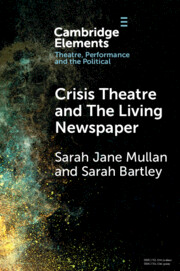Element contents
Crisis Theatre and The Living Newspaper
Published online by Cambridge University Press: 12 March 2024
Summary
- Type
- Element
- Information
- Online ISBN: 9781009525800Publisher: Cambridge University PressPrint publication: 11 April 2024
References
- 2
- Cited by



